
Chicago's architecture is famous throughout the world and one style is referred to as the Chicago School. Much of its early work is also known as Commercial style. In the history of architecture, the first Chicago School was a school of architects active in Chicago at the turn of the 20th century. They were among the first to promote the new technologies of steel-frame construction in commercial buildings, and developed a spatial aesthetic which co-evolved with, and then came to influence, parallel developments in European Modernism. A "Second Chicago School" with a modernist aesthetic emerged in the 1940s through 1970s, which pioneered new building technologies and structural systems, such as the tube-frame structure.

Modern architecture, or modernist architecture, was an architectural style based upon new and innovative technologies of construction, particularly the use of glass, steel, and reinforced concrete; the idea that form should follow function (functionalism); an embrace of minimalism; and a rejection of ornament. It emerged in the first half of the 20th century and became dominant after World War II until the 1980s, when it was gradually replaced as the principal style for institutional and corporate buildings by postmodern architecture.

Garfield Park is a 184-acre (0.74 km2) urban park located in the East Garfield Park neighborhood on Chicago's West Side. It was designed as a pleasure ground by William LeBaron Jenney and is the oldest of the three large original Chicago West Side parks. It is home to the Garfield Park Conservatory, one of the largest plant conservatories in the United States. It is also the park furthest west in the Chicago park and boulevard system.
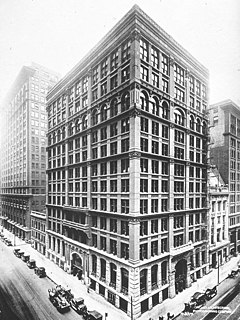
The Home Insurance Building was a skyscraper that stood in Chicago from 1885 to 1931. Originally ten stories and 138 ft (42.1 m) tall, it was designed by William Le Baron Jenney in 1884 and completed the next year. Two floors were added in 1891, bringing it to 180 feet. It is frequently noted as the first tall building to be supported both inside and outside by a fireproof structural steel and metal frame, which included reinforced concrete. It is thus often considered the world's first skyscraper, although this is disputed.
The year 1891 in architecture involved some significant architectural events and new buildings.
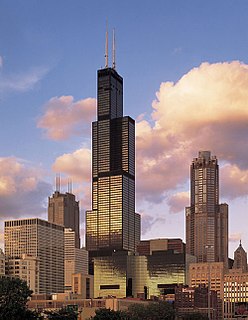
The buildings and architecture of Chicago have influenced and reflected the history of American architecture. The built environment of Chicago is reflective of the city's history and multicultural heritage, featuring prominent buildings in a variety of styles by many important architects. Since most structures within the downtown area were destroyed by the Great Chicago Fire in 1871 Chicago buildings are noted for their originality rather than their antiquity.

William LeBaron Jenney was an American architect and engineer who is known for building the first skyscraper in 1884 and became known as the Father of the American skyscraper.
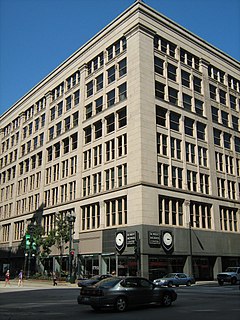
The Second Leiter Building, also known as the Leiter II Building, the Sears Building, One Congress Center, and Robert Morris Center, is located at the northeast corner of South State Street and East Ida B. Wells Drive in Chicago, Illinois. The building is not to be confused with the present Willis Tower, formerly the Sears Tower, constructed and owned by the famous nationwide mail-order firm Sears, Roebuck & Company. This landmark of the Chicago school of architecture gained fame for being one of the earliest commercial buildings constructed with a metal skeleton frame remaining in the United States.
Marshall Field's was a department store in Chicago, Illinois, founded in the 19th century that grew to become a large chain before being acquired by Macy's, Inc in 2005.
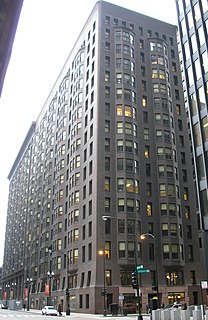
The Monadnock Building is a 16-story skyscraper located at 53 West Jackson Boulevard in the south Loop area of Chicago. The north half of the building was designed by the firm of Burnham & Root and built starting in 1891. The tallest load-bearing brick building ever constructed, it employed the first portal system of wind bracing in America. Its decorative staircases represent the first structural use of aluminum in building construction. The south half, constructed in 1893, was designed by Holabird & Roche and is similar in color and profile to the original, but the design is more traditionally ornate. When completed, it was the largest office building in the world. The success of the building was the catalyst for an important new business center at the southern end of the Loop.
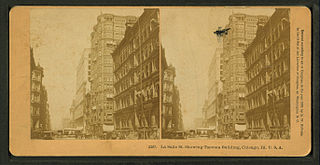
The architectural firm now known as Holabird & Root was founded in Chicago in 1880. Over the years, the firm has changed its name several times and adapted to the architectural style then current — from Chicago School to Art Deco to Modern Architecture to Sustainable Architecture.

The Manhattan Building is a 16-story building at 431 South Dearborn Street in Chicago, Illinois. It was designed by architect William Le Baron Jenney and constructed from 1889 to 1891. It is the oldest surviving skyscraper in the world to use a purely skeletal supporting structure. The building was the first home of the Paymaster Corporation, and is listed on the National Register of Historic Places on March 16, 1976, and designated a Chicago Landmark on July 7, 1978.
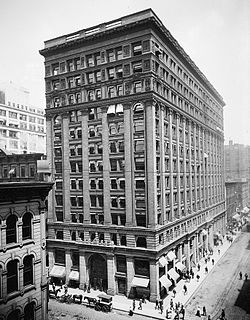
The New York Life Insurance Building is a 14-story building at 39 South LaSalle Street in the Loop neighborhood in Chicago, Illinois. Designed by William Le Baron Jenney, it was completed as a 12-story structure in 1894 at a cost of US$800,000. In 1898, Jenney designed a 92 ft (28 m) addition to the east of the original structure. This expanded the Monroe Street facade to 233 ft (71 m). The addition contained 13 floors and an additional floor was added to the first structure. The expansion also added an entrance on Monroe Street and enlarged the lobby. In 1903, a fourteenth floor was added bring the building to its current height.

Douglass Park is a large Chicago Park District park that serves as a cultural and community center on the West Side of Chicago, Illinois. Established in 1869 and initially named South Park, its 173 acres (0.70 km2) are in the North Lawndale community area with an official address of 1401 S. Sacramento Drive.

The Riverside Historic District, also known as Riverside Landscape Architecture District, encompasses what is arguably one of the first planned communities in the United States. The district encompasses the majority of the village of Riverside, Illinois, a suburb just west of Chicago. It was planned and designed by Calvert Vaux and Frederick Law Olmsted, and features a number of architecturally distinguished buildings.

The Exelon Pavilions are four buildings that generate electricity from solar energy and provide access to underground parking in Millennium Park in the Loop community area of Chicago in Cook County, Illinois, United States. The Northeast Exelon Pavilion and Northwest Exelon Pavilion are located on the northern edge of the park along Randolph Street, and flank the Harris Theater. The Southeast Exelon Pavilion and Southwest Exelon Pavilion are located on the southern edge of the park along Monroe Street, and flank the Lurie Garden. Together the pavilions generate 19,840 kilowatt-hours (71,400 MJ) of electricity annually, worth about $2,350 per year.

The Everett McKinley Dirksen United States Courthouse, commonly referred to as the Dirksen Federal Building, is a skyscraper in the Chicago Loop at 219 South Dearborn Street. It was designed by Ludwig Mies van der Rohe and completed in 1964. The building is 384 feet (117 m) tall with 30 floors; it was named for U.S. Congressman Everett Dirksen. The building houses the United States Court of Appeals for the Seventh Circuit, the United States District Court for the Northern District of Illinois, the United States Bankruptcy Court, the United States Marshal for the Northern District of Illinois, United States Attorney for the Northern District of Illinois, and local offices for various court-related federal agencies, such as the Federal Public Defender, United States Probation Service, United States Trustee, and National Labor Relations Board. It is one of three buildings making up the modernist Federal Plaza complex designed by van der Rohe, along with the U.S. Post Office and the Kluczynski Federal Building. Separate from the Federal Plaza, but opposite the Kluczynski Building across Jackson Boulevard, is the Metcalfe Federal Building.

19 South LaSalle Street, formerly known as the Central YMCA Association Building, is a building in downtown Chicago, Illinois. It was constructed in 1893 and designed by the architecture firm Jenney & Mundie.

The Tacoma Building is an early skyscraper in Chicago. Completed in 1889, it was the first major building designed by the architectural firm Holabird & Roche. The Tacoma Building was demolished in 1929 to be replaced by One North LaSalle.
Mundie & Jensen was an architectural firm in Chicago, Illinois. Several of its works are listed on the National Register of Historic Places (NRHP).

















